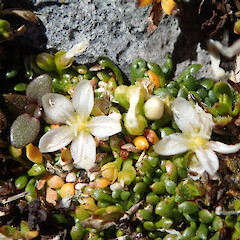Montia drucei
Synonyms
Neopaxia drucei Heenan; Previously all the New Zealand Neopaxia had been known as Neopaxia australasica (Hook.f.) O.Nilsson which is now regarded as an Australian endemic
Family
Montiaceae
Flora category
Vascular – Native
Endemic taxon
Yes
Endemic genus
No
Endemic family
No
Structural class
Herbs - Dicotyledons other than Composites
Current conservation status
The conservation status of all known New Zealand vascular plant taxa at the rank of species and below were reassessed in 2017 using the New Zealand Threat Classification System (NZTCS) – more information about this can be found on the NZTCS website. This report includes a statistical summary and brief notes on changes since 2012 and replaces all previous NZTCS lists for vascular plants.
Please note, threat classifications are often suggested by authors when publications fall between NZTCS assessment periods – an interim threat classification status has not been assessed by the NZTCS panel.
- Conservation status of New Zealand indigenous vascular plants, 2017 . 2018. Peter J. de Lange, Jeremy R. Rolfe, John W. Barkla, Shannel P. Courtney, Paul D. Champion, Leon R. Perrie, Sarah M. Beadel, Kerry A. Ford, Ilse Breitwieser, Ines Schönberger, Rowan Hindmarsh-Walls, Peter B. Heenan and Kate Ladley. Department of Conservation. Source: NZTCS and licensed by DOC for reuse under the Creative Commons Attribution 4.0 International licence.
2017 | Threatened – Nationally Critical | Qualifiers: RR, Sp, St
Previous conservation statuses
2012 | Threatened – Nationally Critical | Qualifiers: RR, St
2009 | Threatened – Nationally Critical | Qualifiers: St
2004 | Threatened – Nationally Critical
Distribution
Endemic. South Island, North West Nelson, Kahurangi National Park, Horseshoe Basin and sinkholes near Mt Arthur.
Habitat
Alpine. A species of damp sites within marble karstfield. It seems to prefer to grow on shallow, skeletal soils and on rock outcrops where competition from taller plants is minimal. Specimens have been seen growing on the margins of sink holes in places that are periodically flooded, tarns, at the toe slope of scree and adjacent herbfield.
Detailed description
Diminutive stoloniferous herb of damp ground within marble karstfield, forming loose to compact turf up to 50 mm diam. Leaves 15 x 1 mm, lamina 1-3 mm, elliptic to rhomboid; petiole distinct; leaf surfaces initially green fading to yellow with age, glossy, upper surface convex, lower concave; apex subacute; base attenuate to cuneate. Flowers 4.8-6.2 mm diam. Tepals 2-3.6 x 1.5-2.5 mm, obovate, white, overlapping; apex subacute, not notched; claw indistinct. Nectary green. Filaments 1.5-2.5 mm, greater than half tepal length. Anthers 0.3-0.4 x 0.2 mm, pink to pink-red. Ovary 0.6-0.8 x 0.8-0.9 mm, obovoid, green. Style 0.9-1.2 mm; somewhat bulbous at base, white with base flushed green. Stigmatic branches 0.9-1 mm, white, straight prior to spreading. Capsule 1.5-2 x 1-1.5 mm. Seeds 1-1.5 x 0.9-1.2 mm, black, moderately to strongly rugose.
Similar taxa
None known
Flowering
December - Feburary
Flower colours
Green, White
Fruiting
January - March
Propagation technique
Easily grown form the division of whole plants but difficult to maintain in cultivation for any length of time.
Threats
Known from one area near Mt Arthur (Kahurangi National Park). Its habitat preferences appear to be very specific, and as such this species is naturally very uncommon. It is because of its highly restricted range and area of occupancy that this species receives such a high risk assessment. At this stage no other threats to this species have been recognised.
Etymology
montia: Named after the Italian botanist, Giuseppe Monti (1682-1760);
drucei: Named after Anthony (Tony) Peter Druce, one of New Zealand’s most respected field botanist (1920-1999).
New Zealand Botanical History
For a brief biography for this plant is named, see this article in Te Ara - The Encyclopedia of New Zealand. Hundreds of Tony’s famed plant lists can be found here and back-issues of regional Botanical Society Journals which he contributed can be accessed here.
Attribution
Fact Sheet prepared for NZPCN by P.J. de Lange 1 July 2009. Description by P.B. Heenan and published in de Lange et al. (2010) - but see also Heenan (1999, 2007).
References and further reading
de Lange, P.J.; Heenan, P.B.; Norton, D.A.; Rolfe, J.R.; Sawyer, J.W.D. 2010: Threatened Plants of New Zealand. Canterbury University Press, Christchurch.
Heenan, P. B. 1999: A taxonomic revision of Neopaxia Ö.Nilss. (Portulacaceae) in New Zealand. New Zealand Journal of Botany 37: 213-234
Heenan, P.B. 2007: New combinations in Montia (Portulacaceae). New Zealand Journal of Botany 45: 437-439
NZPCN Fact Sheet citation
Please cite as: de Lange, P.J. (Year at time of access): Montia drucei Fact Sheet (content continuously updated). New Zealand Plant Conservation Network. https://www.nzpcn.org.nz/flora/species/montia-drucei/ (Date website was queried)







